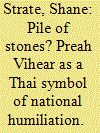| Srl | Item |
| 1 |
ID:
120005


|
|
|
|
|
| Publication |
2013.
|
| Summary/Abstract |
The most recent border tensions between Thailand and Cambodia represent only the latest round of conflict over the status of Preah Vihear (Thai: Phra Viharn). This article uses newspaper and archival material to explore the modern history of the temple, largely from the Thai perspective, and focuses on how Preah Vihear has become the centrepiece of a Thai discourse on National Humiliation. Beginning with Prime Minister Phibun Songkhram's irredentist campaign of 1940, the Thai have associated these ancient ruins with the legacy of Western imperialism, particularly the territory 'lost' to French Indochina. For Thai nationalists, the 1962 international court case that awarded sovereignty over the temple site to Cambodia is an example of neo-imperialism that is part of this legacy. Thai media coverage of the court case compared the Preah Vihear situation with past defeats, including the loss of the four provinces in 1946 and the Franco-Siamese crisis of 1893. Conversely, Sihanouk and Cambodian leaders constructed a counter-narrative that compared Thai claims to Preah Vihear with the long history of Siamese imperialism in the region. It is Preah Vihear's centrality in National Humiliation discourse, rather than its religious or architectural significance, which makes it a powerful icon.
|
|
|
|
|
|
|
|
|
|
|
|
|
|
|
|
| 2 |
ID:
101922


|
|
|
|
|
| Publication |
2011.
|
| Summary/Abstract |
The 1940 Franco-Thai border conflict coincided with the beginning of a four-year campaign to weaken the Catholic Church's position in Thailand. The government closed down schools, confiscated property and imprisoned clergy. Angry mobs looted and burned churches, while the local populace boycotted businesses owned by Catholic Thais. The state-led persecution was part of a broad effort to deal with the legacy of western imperialism in Thailand. Catholicism's strong association with French colonialism, combined with France's decline, made the Church the ideal target for anti-imperialist forces. This overlooked incident provides strong evidence that Phibun Songkhram's strategy was not simply to survive the war, as historians have often claimed. The anti-Catholic campaign, which complicated the country's post-war status, was part of an attempt to re-position the country vis-à-vis the West and provide complete independence for Thailand.
|
|
|
|
|
|
|
|
|
|
|
|
|
|
|
|